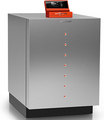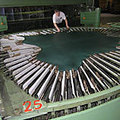Tweaking Flight Paths and Landings Can Cut Airline Fuel Use by 15 Percent
by: Eco Geek Latest, 2011-01-12 16:02:19 UTC

Southwest Airlines has rolled out a new set of guidelines for flight paths and landings for its aircraft at 11 airports that has resulted in fuel savings of five to 15 percent per flight. The new guidelines called Required Navigation Performance (RNP) could be introduced to all airports and airlines in the coming years.
The RNP procedures change flight patterns in two major ways: they allow aircraft to track much tighter flight paths than current traffic control systems require and they also call for a continuous glide down to landing opposed to the punctuated, step-down approach mainly used. These seemingly small tweaks have added up to major fuel savings -- already saving Southwest $11 million in fuel costs a year just at the initial 11 airports and could save up to $60 million a year when extended to all of its airports.
In an industry that accounts for two percent of global greenhouse gas emissions, those fuel savings will also amount to a nice reduction in emissions.
GE Aviation has been testing RNP technology for airplanes and Boeing has outfitted 345 of its 737-700s with the technology supporting those flight patterns. The Federal Aviation Administration is hoping to get RNP procedures, as well as other efficiency measures, into all of the country's airports soon, although the upgrade and requisite training will likely cost $6 billion - $7 billion.
via Earth2Tech
Brooklyn Compost Company Vokashi Cleans Up Your Kitchen Waste
by: Inhabitat , 2011-01-11 22:29:11 UTC

Here at Inhabitat, we’ve long praised the environmental benefits of composting, but we understand that the thought of rotting food or a worm bin in your kitchen can be a turn-off. But fear no more, eco-friends, Vokashi, a new Brooklyn composting company, is here to clean up your kitchen waste in an easy, green, smell-free way.
Read the rest of Brooklyn Compost Company Vokashi Cleans Up Your Kitchen Wastehttp://www.inhabitat.com/wp-admin/ohttp://www.inhabitat.com/wp-admin/options-general.php?page=better_feedptions-general.php?page=better_feed
Permalink |
Add to
del.icio.us |
digg
Post tags: apartment composting, bran fertilizer, brooklyn composting companies, brooklyn composting services, composting in new york, composting services, composting with em-1 bacteria, East New York Farms, em-1 bacterial agent, fermenting food scraps, new york composting services, sustainable living, urban agriculture nyc, vandra thornburn, vokashi, vokashi brooklyn, vokashi composting, vokashi composting service
Best Buy Launches Instant Rebates on Take-Back
by: Environmental Leader, 2011-01-11 14:14:19 UTC

 Retailer Best Buy has launched a buy-back program aimed at the frequent electronics buyer.
Retailer Best Buy has launched a buy-back program aimed at the frequent electronics buyer.
For a fee, customers can join the Buy Back Program when they purchase laptops, netbooks, tablets, televisions and cell phones at Best Buy.
The retailer will then buy the product back from the consumer at any time within two years, or within four years for televisions – though TVs costing over $5,000 are ineligible. Customers will receive up to 50 percent of the original price in the form of store credit, which must be redeemed within six months.
All products will then be refurbished and resold, or recycled. Devices returned under the program must be in good working condition and include all their original parts.
Rates of reimbursement under the Buy Back Program will depend oon how long customers own their products, and TVs are only eligible for a 10 percent rebate.
Best Buy has positioned the initiative as a way for customers to buy the latest products without fears about obsolescence, while earning immediate credit towards their next purchase. The retailer already offers a free trade-in program that gives customers gift cards for dropping off their old electronics.
Best Buy has offered electronics recycling at all of its U.S. locations since February 2009, and is a member of the Environmental Protection Agency’s (EPA) Responsible Appliance Disposal program.
The company plans to collect 1 billion pounds of used consumer electronics, or e-waste, over the next five years.
 Graphene Could be Key to Better, Cheaper Organic Solar Cells
Graphene Could be Key to Better, Cheaper Organic Solar Cells
by: Eco Geek Latest, 2011-01-11 16:02:15 UTC

Researchers at MIT believe that the use of graphene as an electrode material in organic solar cells could make them cheaper to produce and could open up a host of new applications for the technology.
Organic solar cells are constantly improving and have great potential, but some issues are still holding them back from really taking off. The efficiency of such cells still lags behind that of traditional silicon cells and, so far, the only electrode material that has been successful is rare and expensive indium-tin-oxide (ITO).
The researchers have begun experimenting with inexpensive and readily available graphene, a form of carbon where the atoms form a flat sheet just one atom thick, arranged like chicken-wire, as an electrode. The use of graphene has lots of benefits over ITO, namely transparency. Because it's transparent just like the organic solar cells themselves, the cells could be applied to windows or even on top of other solar panels, boosting overall electricity output. Graphene is also flexible, where ITO is rigid, meaning the cells could be applied to irregular wall or rooftop surfaces and folded or rolled for easy transportation.
And, just as importantly, the graphene's performance as an electrode material is very similar to the ITO, making it a suitable replacement.
via Physorg
 Soap Flakes bar soap dispensers lets you use bar soap just as liquid soap
Soap Flakes bar soap dispensers lets you use bar soap just as liquid soap
by: The Design blog, 2011-01-11 10:44:20 UTC

What is the first thing that comes to your mind when you think of block soap? A slippery and unhygienic bar that is used again and again by numerous hands? If that’s what you think it’s high time to think again. Nathalie Stämpfli, a designer from Switzerland, is going to change the mind set about the bar soap. She has designed a few little wonders dubbed the “Soap Flakes” in the form of bar soap dispensers. One of their kind, the dispensers enable the user to use the bar soap just as liquid soap. The Swiss designer has pooled the handiness of a liquid soap dispenser with the ecological and logistical benefits of bar soap.
These easy to use dispensers turn the bar soap into beautiful flakes that easily dissolves in water and leave a sensational fragrance in your hands. It is a great breakthrough, as it is eco-friendly and easy in the terms of logistic. It benefits the environment, as it eliminates the use of plastic bottle and one can use handmade paper instead to store it.



Via: Nathalie Stämpfli


 Transformer Furniture Goes Mainstream in New York Times
Transformer Furniture Goes Mainstream in New York Times
by: TreeHugger Design, 2011-01-06 15:53:08 UTC
 Image credit: Carolina George
Image credit: Carolina George
A decade ago in Toronto,
Julia West Home introduced a line of tables, beds and even spinning bookcases that served multiple functions and took up less space. I designed some of them (
see them here), convinced that this was the future of furniture.
The future has been a long time coming, but now it is in the
New York Times, which int...
Read the full story on TreeHugger
Readymade's Top 20 Projects of 2010
by: TreeHugger Design, 2011-01-11 21:00:00 UTC

There's a lot of great green ideas in
Readymade's Top 20 Projects of 2010. Minimalist vases from light bulbs, kitchen cabinets from wine crates, wallets from comic books, upgraded dresses, outdoor solar showers.... brilliant ideas for low eco-footprint living. ...
Read the full story on TreeHugger
“Sustainism: It’s Got a Name, Now Do It” - New York Times
by: Dezeen, 2011-01-11 10:28:16 UTC
Dezeenwire: Alice Rawsthorn reviews Sustainism Is the New Modernism, a book by cultural theorist Michiel Schwarz and designer Joost Elffers to be released next month - New York Times


 Lights Out for IKEA Incandescent Bulbs
Lights Out for IKEA Incandescent Bulbs
by: Greener Design, 2011-01-04 21:21:29 UTC
Incandescent light bulbs are no longer among IKEA's extensive product offerings.

 5 FAQs About Hybrid Energy Storage and Efficiency
5 FAQs About Hybrid Energy Storage and Efficiency
by: Greener Design, 2011-01-07 12:30:48 UTC
The promise of battery-ultracapacitor hybrid energy storage is catching the attention of manufacturers across multiple industries spanning numerous applications. Engineers considering the technology are weighing its cost, power, performance and potential for delivering greener, more sustainable future products.












Comments by our Users
Be the first to write a comment for this item.